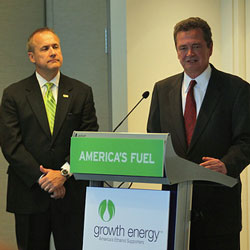 Ft. Bragg might be the home of the U.S. Army’s Airborne soldiers (by the way, as a former Air Force guy, we land those planes … you don’t have to jump out!), but the North Carolina post soon could be known as the home to clean air, born of biodiesel!
Ft. Bragg might be the home of the U.S. Army’s Airborne soldiers (by the way, as a former Air Force guy, we land those planes … you don’t have to jump out!), but the North Carolina post soon could be known as the home to clean air, born of biodiesel!
The Fayetteville (NC) Observer reports that the Army recently highlighted biodiesel during Ft. Bragg’s recent Green Living & Design Tour:
Fort Bragg is now served by seven separate shuttle routes. The buses are powered by B-20 fuel, which is 20 percent biodiesel fuel and 80 percent petroleum diesel fuel, and are hybrid electric diesel buses. Emissions reduction is about 20 percent and may be as much as 70 percent with hybrid technology, according to the Fort Bragg green tour fact sheet…
Fort Bragg has the ability to transform used cooking oil into biodiesel.
Eric Torres, who works in Pollution Prevention with the Environmental Compliance Branch, travels to 24 dining facilities with a 55-gallon drum and picks up cooking oil from storage tanks.
A processor turns 50 gallons of oil into 45 gallons of biodiesel, which is used in some forklifts and other heavy machinery around post.
The Directorate of Public Works is using these batches of biodiesel in two forklifts and a skid steer.
A Special Forces unit also is testing the biodiesel in one of its skid steers…
The Directorate of Public Works hopes to use biodiesel in all of its vehicles, then spread it to all the directorates on Fort Bragg, Torres said.
The Army could have produced 12,000 gallons of biodiesel last year, if all of the used cooking oil would have been turned into the green fuel. Officials hope to acquire a newer, bigger processor soon.


 Growth Energy CEO Tom Buis says Nussle will provide immediate value to the organization. “Jim’s experience on Capitol Hill and his ability to manage large teams will be huge assets to Growth Energy,” Buis said. “As a former Iowa Congressman, he also possesses the knowledge of ethanol and agriculture that will allow him to hit the ground running and be a powerful advocate for America’s ethanol supporters.”
Growth Energy CEO Tom Buis says Nussle will provide immediate value to the organization. “Jim’s experience on Capitol Hill and his ability to manage large teams will be huge assets to Growth Energy,” Buis said. “As a former Iowa Congressman, he also possesses the knowledge of ethanol and agriculture that will allow him to hit the ground running and be a powerful advocate for America’s ethanol supporters.”






